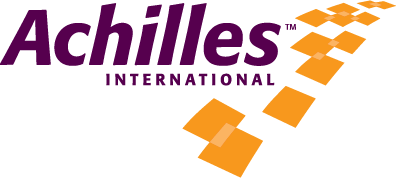A Beginner's Guide to Wheelchair Racing
Wheelchair racing is an exhilarating sport. It offers both physical and mental challenges making it an empowering and rewarding experience. Whether you're looking to compete or just stay active, this guide will help you get started.
Getting Started
Equipment: The first step is to get a racing wheelchair designed specifically for speed and biomechanical efficiency. These wheelchairs are lightweight, with a single front wheel and two large rear wheels slightly angled for stability. Obtaining a new racing wheelchair can be very difficult due to their high costs and complex order forms. Achilles International provides access to racing wheelchairs of various sizes for our athletes attending weekly workouts in select locations in New York City. We also help connect athletes with resources where they can get their own adaptive equipment here. Two other mandatory pieces of equipment are helmets and wheelchair racing gloves. (These are a pair I designed for athletes like me.)
Training: Begin with basic training to build strength and endurance. We recommend watching pushing technique videos that can be found on YouTube (here is one I recommend) , or finding an experienced wheelchair racer to guide you. To build cardiovascular endurance, adaptive athletes can do the same track or road workouts as non disabled athletes. Start with pushing one lap around the track, and slowly increase the distance. Consistent training is key to improving speed and stamina. Compliment workouts in the racing chair with strength training at home or in the gym. Focus on upper body and core strength with exercises like bicep curls, shoulder press, bench press, and russian twists.
Learning the Techniques
Pushing: The proper pushing technique is a five step process: Contact, Drive, Release, Lift and Stretch, and Accelerate. The best way to master this is watching other racers, and practice, practice, practice. Pushing a racing wheelchair is very different from pushing a standard wheelchair, so developing an efficient stroke will take time. To learn more about the five steps, check out this video. Having a pair of good fitting gloves is crucial to developing your wheelchair racing stroke.
Turns: Maneuvering turns efficiently is crucial, both on the road and the track. Learn to lean into turns and use your body weight to help control your chair. Practice turning at different speeds to get comfortable with various racing scenarios. For turns on the track, athletes will need to learn how to use your compensator. A compensator is a device on the racing chair that angles your front wheel for each lane on the track so athletes can spend more time pushing and less time turning the chair with the steering column.
Joining a Community
Clubs and Organizations: Connect with local clubs or organizations like Achilles International, which offer resources, coaching, and a supportive community for wheelchair athletes. Finding a community of wheelchair racing athletes will not only increase motivation to improve physical fitness, but it also makes the sport more fun! Check Move United to see if there are any adaptive sport centers in your area.
Events: Participate in local races to gain experience and confidence. These events provide an opportunity to meet other athletes, share tips, and challenge yourself. All Achilles events have a wheelchair racing division and we love having more athletes join us!
First Race Tips and What to Watch Out For
Chair Maintenance: A common mistake that new wheelchair racing athletes make is not knowing how to repair and maintain their equipment. Ensure tires are properly inflated before every race, check that the rubber on the gloves doesn’t have any holes. Check to make sure all three wheels are tightly screwed in and not wobbly, and don’t forget your helmet! Klister is also an important tool for training or racing in wet conditions.
Train First: Often athletes get excited for a competition but they forgot one thing, to train properly! Pushing a half or full marathon is no easy feat, be sure to put in months of training before attempting one of these long distance events. For track competitions, it is essential to practice your starts and complete many workouts with sprints and short bursts of speed.
Staying Motivated
Set Goals: Establish both short and long term goals to keep yourself motivated. Whether it's completing a race or improving your personal best time, having clear objectives will help athletes stay focused. An example of a long term goal is to finish a 10k. Some short term goals to support that could be to push the racing chair four times a week for a month, push at a steady pace for one hour, and finish a 5k in a set amount of time.
Celebrate Progress: Celebrate your achievements, no matter how small. Each milestone is a step towards becoming a better athlete.
Wheelchair racing is a sport that combines physical strength, technique, and determination. By starting with the right equipment, learning proper techniques, and joining a supportive community, you can embark on a fulfilling journey in wheelchair racing. Remember, every push forward is a victory in itself. Happy racing!
Arielle Rausin is the Director of International Chapters and the Wheelchair Racing Coach at Achilles International. In high school she helped create inclusive policies for students across the state of Florida to participate on their high school track teams. She raced for seven years at the University of Illinois’ Paralympic Training Center and was a member of Team USA for three years. She has competed on the track internationally at the Para PanAm Games in Peru and Para Athletics World Championships in Dubai, and has completed over 30 marathons including the six Abbott World Majors. She started coaching in 2021 and now loves helping athletes reach their potential.



